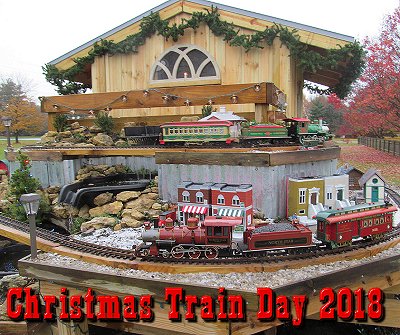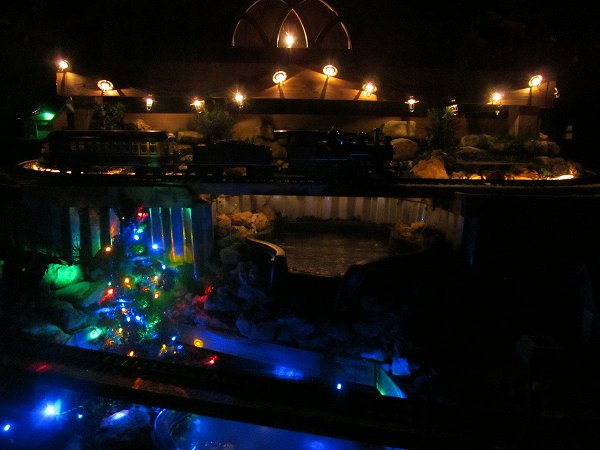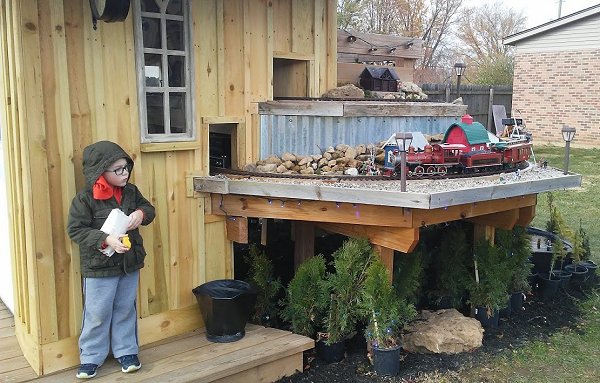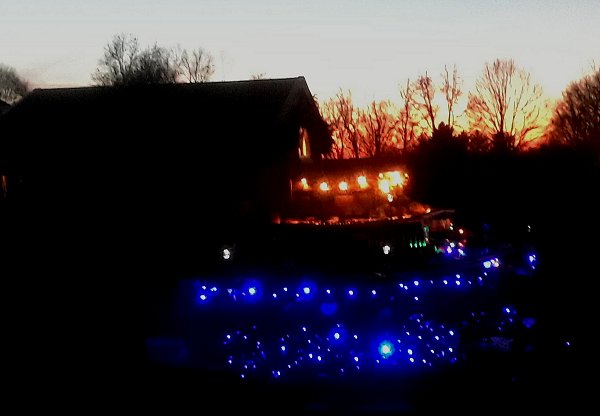 | |||
 |
 |
 | |
 |
 | ||
 |
 | ||
 |  | ||
 |  | ||
 | |||
 |
 |
 | |
 |
 | ||
 |
 | ||
 |  | ||
 |  | ||
| Written by Paul D. Race for Family Garden Trains(tm)
and New Boston and Donnels Creek: |
 |
|
|
Christmas Train Day, 2018Many of the most active model railroaders occasionally have "open railroads," so people can come and see model trains in action, ask questions, and hopefully become more interested in the hobby. Outdoor "Garden" railroaders tend to have their open railroads in the summer, and I've had a few over the years. But back in 2008, at the request of Dayton's NMRA leaders, we started having open railroads in November. The railroad was decorated for Christmas, hot cider and cocoa were served, and a very good time was had by all.In the following years, we set up trains that kids could run, put up more lights, and added Christmas music playing in the background. We have welcomed many fellow model and garden railroaders, but we have welcomed far more friends and family over the years. For many folks it became a way to "jump-start" the holidays. I started calling it "Christmas Train Day" when I invited non-railroaders, because "Christmas-themed open railroad" was just too cumbersome. The history of our first eight celebrations is recorded in the New Boston and Donnels Creek pages. If you go there, just scroll down until you start to see the word "Christmas." That said, we moved in the fall of 2016, and there was no way to have our "annual" event that year, or even the next. There just wasn't enough "infrastructure" in 2017 to invite over a crowd.
So we revived the "annual" Christmas Train Day tradition, albeit on a smaller scale. Still, you have to start somewhere. Preparation was a bit simplified by the fact that I didn't have to do any weeding or trimming. Trimming may come, as I get more conifers established, but this year, the railroad boasted two dwarf English Boxwoods, one Hicks Yew (Taxus), and one Dwarf Alberta Spruce. All are planted in relatively shallow soil on elevated platforms, and none are in any danger of getting out of control. However, having a railroad that is elevated as high as the parts we have done so far brings its own challenges. Camouflaging the Railroad's SupportsWhat will (hopefully) be the "middle" platform of our three-tier railroad sits fairly high about the ground, so the posts, joists, and bare soil almost "stand out" as you approach the railroad. I could put lattice or something around it, but I plan to add another, lower, layer of railroad around it next year, and anything like lattice would just be wasted money. At first I thought of stapling fabric around the posts to provide a kind of "skirt," like you put on display tables at conferences. I even picked up some cheap fabric that I thought would do the job. But we have been having such windstorms lately, I was afraid the fabric would be torn to shreds as soon as it was installed. When Lowes put their evergreens on sale at the end of the season, I picked up a number of the little pots, including Emerald Green Arborvitae, Dwarf Alberta Spruce, and Blue Prince and Princess Holly (always buy male and female holly plants if you want berries). I plan to use most of them for other purposes after Christmas, so this was an investment that will give us a "two-fer."
We did have leftover mulch from a spring project, so I spread that under the railroad. The nice thing about mulch is it looks like you meant it to be there. In other landscaping projects we have said it "covereth a multitude of sins." Then I made wooden stakes by slicing up some boards and drove the stakes right through the bottom of the pots into the ground. If you click on the photo, you'll be able to tell that we also wrapped blue LED lights around them. These are the lights we used to use on the arborvitaes that formed the "background" to our old garden railroad. We started using blue there as a sort of a tribute because they were a favorite of Shelia's lovely late Aunt Anna. We've also learned that blue lights make a nice "background" in general, adding charm, but not drawing attention from the railroad itself. By the way the rock in the photo isn't exactly a "planned feature." I dug it out of the yard this fall because it was threatening my lawnmower blade, and I haven't found a "proper" place for it yet. Lighting the RailroadIf you ever read about, or better yet visited the old railroad in the holiday season, you'll know that we strung colored lights in about thirty miniature trees around the whole railroad. They made the railroad bright and cheery and kept most of the railroad lit well enough to see after dark. Toward the end, I also had little spotlights aiming at points of interest.Only one of trees presently planted on the new railroad was big enough for lights this year. And there was certainly no room or time for setting up spotlights. Running out of time to come up with something spectacularly creative, I started by running a strand of lights that looked like miniature utility lights around the upper portion of the railroad. It helped. But you couldn't really see the waterfalls after dark, and, frankly, they're one of the nicest features of the railroad so far. I investigated several ways to light them, then decided to try running lights on the back side of the bridges. Yes, the bridges are still just 1"x6"s, but they serve a function, and they blend in fine with the rest of the railroad's construction. For the top loop (right) I borrowed a trick from my Cincinnati-area friend Dan Stenger. When Dan decorates his extensive railroad for Christmas, he runs rope lights alongside the right-of-ways. That way, the railroad not only looks more festive, but it's easier to see the trains' progress. The top loop of our railroad, based on 5'-diameter curves, The photo to the right shows the same corner as the photo above it, but from a different angle. In this photo, I've already taken the little station in for the winter, but you can see the platform where it sat. Though the rope light is quite obvious in this photo, it's not so obvious to observers who aren't tall and standing on tippy-toes. I included this photo because it gives you an idea of how the soft lighting from both sources gave a sort of "stage lighting" appearance to this layer. If you click on it to see the "blowup," you'll get a better idea. Next year, I hope to have a better solution for the "overhead" lighting on this layer, and I'll have the rope lighting installed a little more "cleanly." But you have to admit it's a good start. Because the light rope runs inside the right-of-way on that layer, it also runs inside the "bridge," illuminating the area of the top waterfall without being too obviously visible to most visitors.
By the way, except for the novelty "utility" light strand at the top and the rope light, all the light strands I used were LED, and most of them were the tiny kind without the fake plastic shell. I like the look of the tiny lights, and I love that the strands cost about a tenth of what the old strands cost to run. However, one of the side effects of this is that if one is pointed straight at your eyes or your camera, it can seem much brighter than the rest of the lights. Sort of a "laser pointer" effect. That's why in some of the after-dark photos it looks like one light is glaring compared to the rest. When you're walking around the railroad watching the trains you don't even notice. The photo below shows the view from the "front and center." For a point of reference, the Bachmann train is exactly where it was in the photo two up. If you click on the photo to see the "blowup," you'll see how the white rope light casts a glow on the upper part of the water feature, and the colored light strand casts a glow on the lower part of the water feature. It's even cooler when the waterfall is running, but the weather has been so cold that the waterfall has only run one or two days since I put the lights up. Hopefully you get the general idea.  The lower level got a little bit "shorted" on lights this year, but for the first few minutes of darkness, the solar lamps I put on the corners helped. And the train I ran on that level had lighted coaches so it was easier to follow after dark. Decorating the ShedThough I may put lights around the shed in the future, I thought that just putting garland on it this year would be a good first step. The garland was mostly some I used to use on our old house, stretching across our little (12'-long) front porch. I also fastened a "candle" in the back window - you can see its glow in the after-dark photographs above.Invites We also printed up a bunch of invites to hand out. The invite to the right was actually on the Family Garden Trains Facebook page, which is why it doesn't have our address. The invites we handed out to friends and family had our address, in case you wondered. We also printed up a bunch of invites to hand out. The invite to the right was actually on the Family Garden Trains Facebook page, which is why it doesn't have our address. The invites we handed out to friends and family had our address, in case you wondered.
I did the invites in Corel Draw. That way I can easily tweak it for coming years. I set the hours to end at 5:00 instead of 6:00 - our traditional "cutoff." For one thing, they were already predicting unseasonably cold weather. For another, if you say "6:00," and the weather is nice, people show up at 5:45 and want to stay until they're convinced they've seen everything. New Boston BijouAnother traditional part of our Christmas Train Day is a train movie that starts at dusk (usually either Buster Keaton's The General or Polar Express. This year I set up a screen, speakers, DVD player, and projector (not shown), but on the day of the event, it was so cold there was no danger of folks sticking around after dark. I did start the movie in the late afternoon, so it wold be running when it got truly dark.Other TrainsOne aspect of "Christmas Train Day" that has made kids want to come back is the availability of trains they can run. This year, I used two Lionel battery-powered "G Gauge" toy trains that I bought in 2012: a Polar Express and a freight train. Though they came with cheap plastic track, they ran on LGB-style G-gauge track just fine. Even better really. I reviewed them in the article "Lionel's? Toy "G" Trains."Here's a snapshot of the Polar Express. These trains are about half the size they "should be" to be considered scale models, but they are a lot of fun for kids to run with the remote control.  The house we live in now has a big back deck and a porch that wraps around two sides. I set the Lionel battery-powered "G-gauge" Polar Express on brass track on the back deck, and I set a Lionel battery-powered "G-gauge" freight train on a circle of aluminum track on part of the porch. Sorry, I got too busy to take photos of those temporary railroads this year. The photos below show how I set these trains up for Christmas Train Day in 2015.
Yes, the Polar Express shown above has an extra coach (it comes with two). As it turns out, lots of "early adopters" of these sets have gotten tired of replacing the batteries or whatever and have turned them into thrift shops, given them to hobbyists who don't know what to do with them, etc. I've picked up several extra pieces for just a few dollars. That said, when they turn up used, the Polar Express is always missing the little Conductor and Boy figures, and both sets are usually missing the remotes and at least some of the track. The figures aren't an issue for me, since I have the two that came with the set I bought in the store. The track isn't an issue for me, because I run them on garden railroad track anyway. But if you're even halfway tempted to buy either set used, be CERTAIN it has the remote. These trains won't run without it. Don't Buy the New Sets for a Garden Railway - A new complication has just arisen. Lionel has discontinued these sets and replaced them with sets that do NOT run on G gauge track. Instead, they run on 2" track, which at the moment, nobody else is making.
When I got it out to set on the track for this Christmas Train Day, I was pleased with how solid it seemed, even though it's not as nice as the track-powered set Lionel made in the 1980s. (I reviewed that set and the Bachmann set that replaced it here.) But when I tried to set Lionel's "Ready-to_Play" Thomas set on a circle of G gauge track, it wouldn't fit. So I used the chintzy track that came in the box with it for this event. Now that it's been tested by some of the most energetic children I've ever known, I have to tell you, it's a good value overall, with much more play value potential than most plastic toys in its price range. I'll have a review of it later, but for now, if you want to check it out on Amazon, click here. The three battery-powered sets all have a control range of 15-20 feet outside. So I set them a little over 20' apart, and there was no discernable interference. Speaking of Thomas and Friends, I also set up the temporary railroad that I built for an NMRA clinic in March, 2018. It's nearly identical to the one I built in 2007 as a demonstration in a garden railroading clinic. The instructions for building such a railroad are here.  In years past, I've run Thomas on a ground-level railroad and run James on an elevated railroad like this one. This year, however, I thought I'd trot out the newest member of that family (for me, anyway), and put a Bachmann-manufactured Percy on that track. Help from FamilyMy sister Tess, who has been in charge of the popcorn popper the last few events, came down to help. My schoolteacher daughter Emily drove home from Indiana. Both their efforts are well appreciated.
Roy and Sonya's grandsons then helped up set figures out on the railroad. This is a job my daughters have traditionally Also, when we set out figures for our Christmas-themed events, we include many Lemax figures that were originally made to go with the Lemax resin Christmas village pieces. On our new railroad, the resin figures are especially useful - they're less likely to blow off the railroad in high winds than our plastic figures. When I set our plastic figures out next spring, I'll have to figure out how to hold them down better than I did this year - one little boy figure disappeared entirely this fall. After the kids helped set things up, they watched the big trains, ran the "kids' trains," and ate popcorn. Behind the ScenesShelia made cookies and other treats, prepared cider, and much more. On the day of the event, she managed the snack stand, but she also spent time with the families to answer questions and make certain everyone got a snack. Emily helped shepherd some of the youngsters as they ran the trains, etc. Tess helped with many other activities, but especially with the popcorn. Which was a hit. The Official EventBecause I wanted the railroad to look impressive and "Christmassy," I chose two Bachmann ten-wheelers to pull the trains. The green one you see on the top loop in some photos was part of a large "premium" set that Bachmann only offered for a short time. I got it used just for this sort of project. The locomotive has upgraded features, including metal running gear, but the cars have no provision for lighting. I believe that a streetcar was originally packaged with the same set, but I may be mixing up two products. There are actually two coaches, but the couplers on one of the coaches weren't behaving properly and by the time I realized that, it was too late to take it into the shop.The reddish ten-wheeler I ran on the other track was a standard "Big Hauler" from another set, also purchased used. It's pulling an Aristocraft Sierra coach decorated for Christmas. The lighting on this car works. Both locomotives had a choo-choo sound, though with the Christmas music playing, it wasn't as obvious as it might have been otherwise. Roy and Sonya and their grandkids had to leave before the event technically started, but as soon as they left, friends started showing up. We had visitors all afternoon, which, considering the cool temperature of the day, was pretty remarkable. After the last visitor left, we put up the battery trains, Emily collected the little figures, and so on. It wasn't the most remarkable event we ever had, but it was a good "reboot" to a tradition we hope to keep repeating for years to come. I'm told that my youngest great-nephew, just turned three, begged to come back the next day. Too bad they live so far away. As it became dark, we could hear Tom Hanks and see scenes from Polar Express showing up on the screen I had hung on the fence. But no one was sticking around in below freezing weather to watch it this year. So it came down, too. ConclusionOn Thanksgiving, a neighbor brought over some family members, including several children. We had pulled the "children's railroads" up by then, but we put Thomas and Percy on the mainlines and the kids were delighted.Actually, I put Percy on the track first, because the red Bachmann Big Hauler 4-6-0 stopped running, so I moved fast to keep something going. I learned long ago to always have backups for this sort of thing. But the kids were so delighted at seeing Percy, I put Thomas and Annie on the top track and they were even more delighted. Throughout November and early December, we also had several snowfalls that made the railroad look especially "Christmassy," but nobody was over at the time.  In the meantime, snow or not, it's a lot like having a giant Christmas card in the back yard. 
I finally did manage to get one photo with the waterfall running and the lights on, almost a month after the event. That's the photo to the right. I hope to keep some sort of lighting on the water feature even when the Christmas lights are gone. Otherwise, one of the railroad's best features disappears every time it gets dark. As always, if I've helped you get any ideas at all for your next garden railroad construction, I will consider the time it took to document all of this time well spent. Best of luck, all, Enjoy your hobbies, and especially enjoy any time you can spend with your family in the coming season. Paul
Click on the photo to see our progress as of mid-September, 2019.
By the way, going over lumber receipts in early 2019, I couldn't believe I was still siding the train shed in late October, and managed to have an open railroad in mid-November. It is a little crazy how fast things can go together if you have a deadline and a lot of gift cards. Click on the photo to see our progress as of late October, 2018.
Includes choosing the siding and windows, installing the door, painting the windowframes, and adding crosspieces to support the vertical siding boards.
Now the roof is waterproof enough to get us through the next couple of months at least, maybe more.
I thought about bringing in helpers for this part, but a reader commented on how helpful it was to see how one person could do this sort of thing by himself, so I just kept plugging away. Click on the photo to see our progress as of September 13, 2018
Click on the photo to see our status as of August 5, 2018.
The way we got the rafters and ridge board up wouldn't work for everybody, but it worked for us, and hopefully will help other folks to "think outside the box" - literally in this case. Click on the photo to see our progress as of July 14, 2018.
Click on the photo to see our status as of July 9, 2018.
Click on the photo to see our progress as of June 13, 2018.
Click on the photo to see our status as of June 1, 2018.
Click on the photo to see our status as of February 20, 2018
Click on the photo to see our status as of February 20, 2018
Click on the photo to see our status as of November 21, 2017
Click on the photo to see our status as of October 25, 2017
Click on the photo to see our status as of October 15, 2017
Click on the photo to see our status as of October, 10, 2017
Click on the photo to see our status as of September 26, 2017
Click on the photo to see our status as of September 17, 2017
Click on the photo to see our status as of September 7, 2017
Click on the photo to see our status as of August 10, 2017
Click on the photo to see our status as of the end of July, 2017
Click on the photo to see what we were considering as of late May, 2017
Click on the photo to see what we were considering as of late April, 2017
Click on the photo to see what we were considering in early April, 2017
Click on the photo to see what we were considering in March, 2017
Click on the photo to see the home page of Paul's railroad.
|



|

Note: Family Garden Trains?, Garden Train Store?, Big Christmas Trains?, BIG Indoor Trains?, and BIG Train Store? are trademarks of
Breakthrough Communications (www.btcomm.com). All information, data, text, and illustrations on this web site are
Copyright (c) 1999, 2000, 2001, 2002, 2003, 2004, 2005, 2006, 2007, 2008, 2009, 2010, 2011, 2012, 2013, 2014, 2015, 2016, 2017, 2018 by
Paul D. Race. Reuse or republication without prior written permission is specifically
forbidden.
Family Garden Trains is a participant in the Amazon Services LLC Associates Program,
an affiliate advertising program designed to provide a means for sites to earn advertising
fees by advertising and linking to amazon.com.
For more information, please contact us
 |  |
| Visit related pages and affiliated sites: | |||||
| - Trains and Hobbies - | |||||
 |  |
 |
 |
 |  |
 |

|

|  |
 |

|
| - Christmas Memories and Collectibles - | |||||
 |

|
 |

|
 |

|
| - Family Activities and Crafts - | |||||
 |

|

|

|

|

|
| - Music - | |||||

|
 |
 |

|

|

|

|

|

|

|

|

|

|

|

|

|

|

|